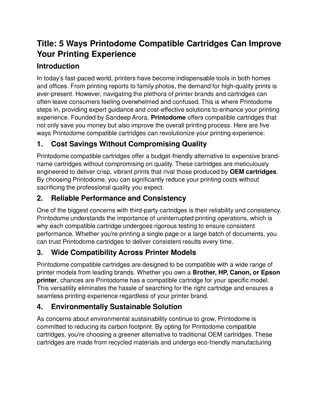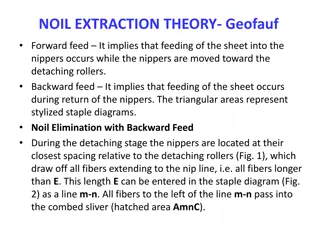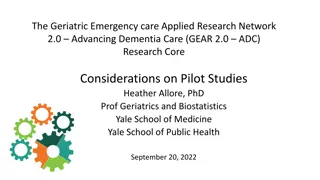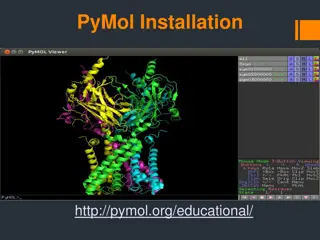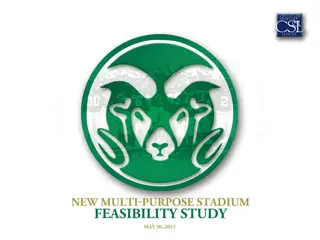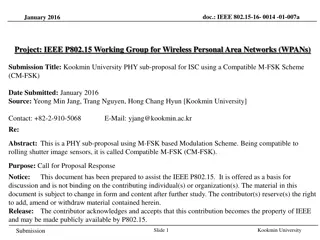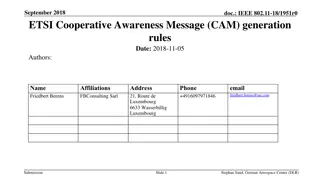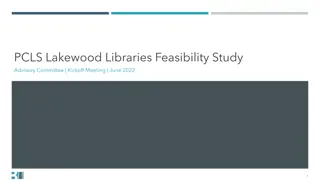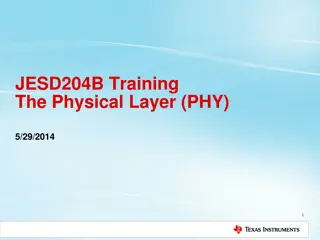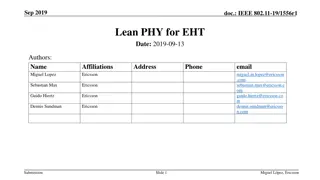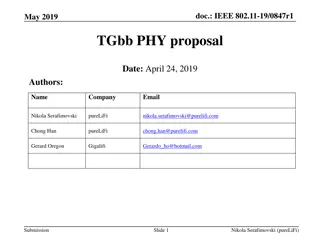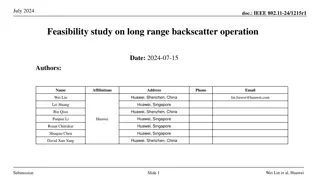
IEEE 802.11-18: Backward Compatible PHY Enhancements Explained
Explore the feasibility and benefits of backward compatible PHY enhancements in IEEE 802.11-18 standard including error correction, parity bytes addition without harming legacy compatibility, and outer code construction techniques.
Download Presentation

Please find below an Image/Link to download the presentation.
The content on the website is provided AS IS for your information and personal use only. It may not be sold, licensed, or shared on other websites without obtaining consent from the author. If you encounter any issues during the download, it is possible that the publisher has removed the file from their server.
You are allowed to download the files provided on this website for personal or commercial use, subject to the condition that they are used lawfully. All files are the property of their respective owners.
The content on the website is provided AS IS for your information and personal use only. It may not be sold, licensed, or shared on other websites without obtaining consent from the author.
E N D
Presentation Transcript
July 2018 doc.: IEEE 802.11-18-XXXXr0 Backward Compatible PHY Feasibility Date: 2018-07-06 Authors: Name Onn Haran Ron Toledano Affiliations Address Autotalks Phone +972-9-866-5300 onn.haran@auto- email Kfar Netter, Israel talks.com Autotalks Kfar Netter, Israel +972-9-866-5300 ron.toledano@auto- talks.com Ariel Feldman Autotalks Kfar Netter, Israel +972-9-866-5300 ariel.feldman@auto- talks.com +972-9-866-5300 leo.menis@auto- talks.com Leo Menis Autotalks Kfar Netter, Israel Submission Slide 1 Onn Haran (Autotalks)
July 2018 doc.: IEEE 802.11-18-XXXXr0 Backward Compatibility PHY Enhancements PHY enhancement is considered backward compatible if a legacy device can decode the data Packet modification isn t possible Adding post-packet data is a potential change Shouldn t harm legacy device operation and access to the network Submission Slide 2 Onn Haran (Autotalks)
July 2018 doc.: IEEE 802.11-18-XXXXr0 Concatenated Error Protection Outer error correction code can be appended to packet, protecting it without changing it Outer code (enc.) Inner code (conv.) 802.11p packet 802.11p data 802.11p data Coded parity Parity Channel Outer code (dec.) Inner code (Viterbi) 802.11p packet 802.11p data 802.11p data Coded parity Parity Submission Onn Haran (Autotalks)
July 2018 doc.: IEEE 802.11-18-XXXXr0 Adding Parity Bytes Without Harming Backward Compatibility Parity bytes can be appended to packet till SIFS Using 802.11 5GHz SIFS (16us) and not the unnecessary long 802.11p SIFS (32us) Parity bytes are ignored by DIFS state machine Caveat: very close vehicles might exceed -62dBm energy detect threshold 16uS SIFS 802.11p packet Parity 58uS 11p DIFS Legacy device receives packet while ignoring parity bytes NGV device benefits from coding gain Submission Onn Haran (Autotalks)
July 2018 doc.: IEEE 802.11-18-XXXXr0 Outer Error Correction Code Reed-Solomon (RS) is commonly used as outer code Can correct (N-K)/2 bytes by adding (N-K) parity bytes to N bytes block Low complexity decoding Packet is divided to blocks where each block is encoded / decoded independently. Last block may be shorter Validation of parity bytes existence isn t needed Decoding isn t performed on packets with good CRC When CRC is bad, and parity bytes are missing, RS decoding may introduce more errors, but packet isn t good anyhow, so no harm is done 802.11p packet Parity Block 1 Block 2 Block 3 P1 P2 P3 Submission Slide 5 Onn Haran (Autotalks)
July 2018 doc.: IEEE 802.11-18-XXXXr0 Outer Code Construction Entire parity bytes should fit 5 symbols (58-16=42us) Avoiding tailing bits is recommended Increases number of available parity bytes, but complicates coding Code can be selected per packet according to packet length Code RS(86, 80) Max. decoded length 400 MCS Tail bits No 1 RS(166, 160) RS(250, 244) RS(248, 244) RS(250, 244) 800 1220 1708 2440 1 1 1 3 No No Opt. No Submission Slide 6 Onn Haran (Autotalks)
July 2018 doc.: IEEE 802.11-18-XXXXr0 Outer Code Gain MCS=1, 239 bytes packet, 1RX ~3dB gain [C2C_highway_NLOS_enhanced (Doppler=2352Hz)] ~0.5dB gain [AWGN] ~1.5dB [C2C_highway_LOS_enhanced (Doppler = 1176Hz)] Submission Slide 7 Onn Haran (Autotalks)
July 2018 doc.: IEEE 802.11-18-XXXXr0 Summary Enhanced PHY messages are received by 802.11p devices and increase NGV devices communication range Not impacting legacy IEEE802.11p reception, network access and fairness Forward looking solution, supporting high network load Utilizing long DIFS period for outer error correction code bytes High gain (~3dB) is achieved on complex channels, where range increase is desired Simple channels have low gain (~1dB) but communication range already surpasses requirements by far Submission Slide 8 Onn Haran (Autotalks)




